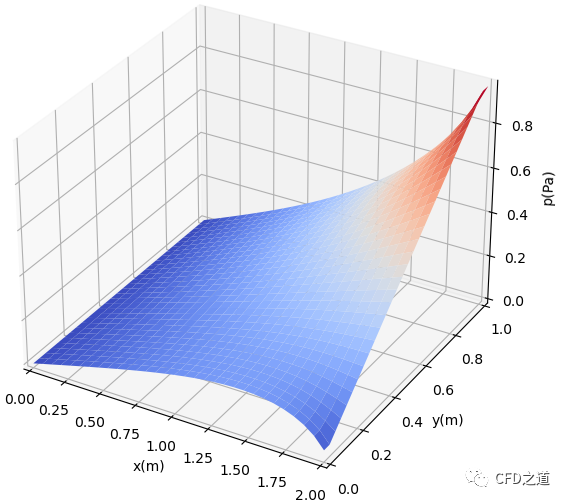二维拉普拉斯方程为:
拉普拉斯方程通常采用中心差分进行离散。离散方程为:
整理为迭代形式:
注:
拉普拉斯方程是一个稳态模型。
”
计算区域内部初始条件,边界条件为:
对于此边界条件和初始条件,可以有解析解:
代码
using PyPlot
matplotlib.use("TkAgg")
function plot2D(x,y,p)
fig = PyPlot.figure(figsize=(11,7),dpi=100)
PyPlot.plot_surface(x,y,p,rstride=1,cstride=1,cmap=ColorMap("coolwarm"))
xlim(0,2)
ylim(0,1)
xlabel("x(m)")
ylabel("y(m)")
zlabel("p(Pa)")
PyPlot.show()
end
定义拉普拉斯模型计算函数。
# normal_target为收敛残差
function laplace2D(p,y,dx,dy,l1norm_target)
l1norm = 1;
pn = zeros(size(p))
tol = 1000;
count = 1;
while (l1norm > l1norm_target || count < tol)
pn = copy(p);
p[2:end-1,2:end-1] = (dy^2*(pn[2:end-1,3:end]+pn[2:end-1,1:end-2])+dx^2*(pn[3:end,2:end-1]+pn[1:end-2,2:end-1]))/(2*(dx^2+dy^2))
p[:,1] .= 0; ##p = 0 @ x = 0
p[:,end] = y; ##p = y @ x = 2
p[1,:] = p[2,:] ##dp/dy = 0 @ y = 0
p[end,:] = p[end-1,:] ##dp/dy = 0 @ y = 1
l1norm = LinearAlgebra.norm((p-pn)./pn,1)
count +=1;
end
return p
end
定义一些变量参数。
##variable declarations
nx = 31;
ny = 31;
c = 1;
dx = 2/(nx-1);
dy = 2/(ny-1);
##初始条件
p = zeros((ny,nx)) ;
x = range(0,2,length = nx);
y = range(0,1,length = ny);
##边界条件
p[:,1] .= 0;
p[:,end] = y;
p[1,:] = p[2,:];
p[end,:] = p[end-1,:];
# plot2D(x, y, p)
p = laplace2D(p, y, dx, dy, 1e-4);
plot2D(x, y, p)
下面可以利用查看初始值分布。
plot2D(x,y,p)
初始分布如下图所示。

变量p在区域内取值为0,在x=2的位置,p的值等于y的值。
下面利用laplace2d函数计算并显示计算结果。
p = laplace2d(p,y,dx,dy,1e-4)
plot2D(x,y,p)
计算结果如下图所示。

完整代码如下所示。
using PyPlot
using LinearAlgebra
matplotlib.use("TkAgg")
function plot2D(x,y,p)
fig = PyPlot.figure(figsize=(11,7),dpi=100)
PyPlot.plot_surface(x,y,p,rstride=1,cstride=1,cmap=ColorMap("coolwarm"))
xlim(0,2)
ylim(0,1)
xlabel("x(m)")
ylabel("y(m)")
zlabel("p(Pa)")
PyPlot.show()
end
# normal_target为收敛残差
function laplace2D(p,y,dx,dy,l1norm_target)
l1norm = 1;
pn = zeros(size(p))
tol = 1000;
count = 1;
while (l1norm > l1norm_target || count < tol)
pn = copy(p);
p[2:end-1,2:end-1] = (dy^2*(pn[2:end-1,3:end]+pn[2:end-1,1:end-2])+dx^2*(pn[3:end,2:end-1]+pn[1:end-2,2:end-1]))/(2*(dx^2+dy^2))
p[:,1] .= 0; ##p = 0 @ x = 0
p[:,end] = y; ##p = y @ x = 2
p[1,:] = p[2,:] ##dp/dy = 0 @ y = 0
p[end,:] = p[end-1,:] ##dp/dy = 0 @ y = 1
l1norm = LinearAlgebra.norm((p-pn)./pn,1)
count +=1;
end
return p
end
##variable declarations
nx = 31;
ny = 31;
c = 1;
dx = 2/(nx-1);
dy = 2/(ny-1);
##初始条件
p = zeros((ny,nx)) ;
x = range(0,2,length = nx);
y = range(0,1,length = ny);
##边界条件
p[:,1] .= 0;
p[:,end] = y;
p[1,:] = p[2,:];
p[end,:] = p[end-1,:];
# plot2D(x, y, p)
p = laplace2D(p, y, dx, dy, 1e-4);
plot2D(x, y, p)
本篇文章来源于微信公众号: CFD之道








评论前必须登录!
注册